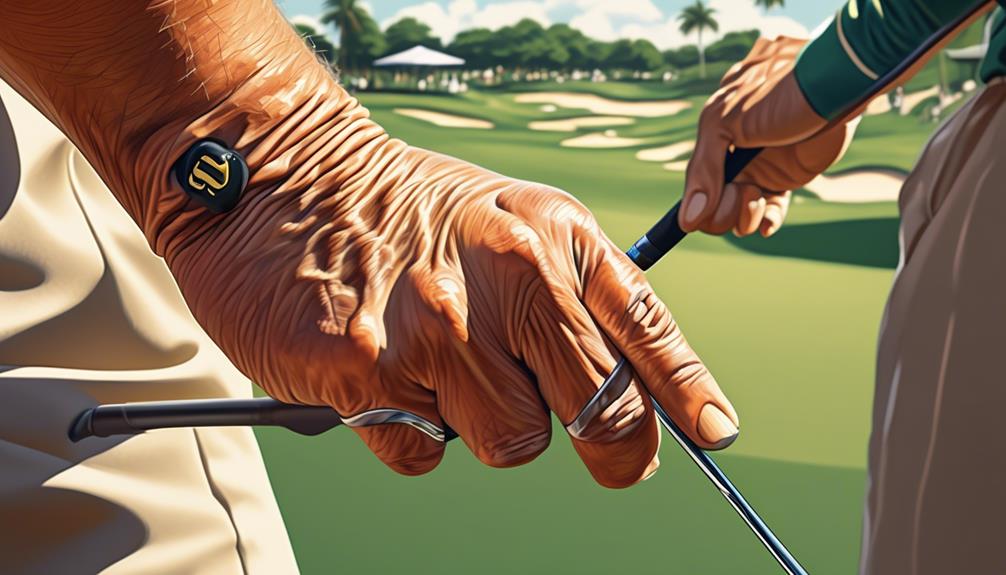

You've spent countless hours on the golf course, swinging and swinging, hoping to perfect your game. But something is missing.
You've watched the pros on TV, marveling at their effortless swings and enviable accuracy. What is their secret? How do they consistently hit those long drives and sink those crucial putts?
Well, my friend, you're in luck. In this discussion, we will uncover 13 key insights from a golf legend that will transform your swing and take your game to a whole new level.
Get ready to unlock the mysteries of the perfect swing and unleash your true potential on the course.
Key Takeaways
- Building a strong foundation of fundamental techniques is crucial for success in golf.
- The proper grip, such as Jack Nicklaus' signature grip, greatly influences the swing and overall success on the greens.
- A balanced and aligned stance is essential for a powerful and accurate swing.
- Understanding the swing plane and maintaining proper body alignment throughout the swing enhances performance on the golf course.
The Early Years


In the early years, golf legend's journey began with a determination that would shape his destiny on the greens. His early development in the sport was marked by a passion that ignited during his childhood training. From a young age, he showed a natural affinity for the game, spending countless hours practicing his swing and honing his skills. It was clear that he possessed a unique talent, and his parents recognized this potential early on.
Under the guidance of experienced coaches, his childhood training focused on building a strong foundation of fundamental techniques. He learned the importance of balance, grip, and posture, which formed the bedrock of his golfing prowess. Every aspect of his game was meticulously analyzed and improved, from his drive off the tee to his precision on the putting green.
Beyond the technical aspects, his early development in golf also involved mental conditioning. He learned the art of focus and concentration, a skill that would prove invaluable in high-pressure situations. Through disciplined practice and a relentless work ethic, he cultivated a mindset of resilience and determination that would serve him well throughout his career.
The early years laid the groundwork for his future success. It was during this formative period that he forged his identity as a golfer, setting the stage for the remarkable achievements that lay ahead.
Natural Talent and Determination


Building upon the foundation of his early development, the golf legend's journey into the realm of 'Natural Talent and Determination' unveils the remarkable fusion of his innate abilities and unwavering drive.
From the very beginning, it was evident that he possessed a natural talent for the sport. His swing was smooth, his precision unmatched, and his ability to read the course seemed almost intuitive.
But it was his determination that truly set him apart from his peers. While others may have relied solely on their natural talent, he understood that true greatness required something more. It required relentless practice, a hunger for improvement, and a refusal to settle for anything less than perfection.
He pushed himself to the limits, both physically and mentally, never allowing setbacks to deter him from his goals. It was this combination of natural talent and unwavering determination that propelled him to the pinnacle of the golfing world.
And even in his success, he never lost sight of the fact that his achievements weren't solely the result of his talent, but rather the product of his relentless pursuit of greatness.
Jack Nicklaus' Signature Grip


With a grip that became synonymous with his name, Jack Nicklaus revolutionized the way golfers held their clubs. Jack Nicklaus' grip is known for its proper hand placement, which greatly influenced his swing and contributed to his success on the golf course. Here are two key aspects of Nicklaus' grip that create a vivid image in the audience's mind:
- Firm and Stable: Nicklaus' grip involved placing the club in the fingers of both hands, rather than the palms. This allowed for a secure hold and a more controlled swing. Imagine gripping the club with your fingers, feeling the firmness and stability as you prepare to strike the ball.
- Interlocking Fingers: Another distinctive feature of Nicklaus' grip was the interlocking of his pinky finger on the trailing hand with the index finger on the lead hand. This interlocking provided additional support and created a unified grip. Envision the sensation of your fingers intertwining, creating a strong connection between your hands and the club.
The Importance of Proper Stance


To excel in golf, it's crucial to understand the importance of a proper stance. Your foot positioning sets the foundation for a powerful swing, ensuring balance and stability throughout your body.
Additionally, maintaining a stable shoulder position allows for a smooth and controlled movement, enhancing your accuracy and control.
Correct Foot Positioning
Proper foot positioning is a crucial element in achieving a solid and powerful golf swing. The importance of weight distribution can't be overstated. By placing your feet shoulder-width apart and aligning them parallel to the target line, you create a stable foundation for your swing. This allows for better weight transfer and balance throughout the swing, maximizing your power and control.
Maintaining balance during the swing is another key aspect of foot positioning. As you pivot and rotate your body, your feet play a vital role in keeping you grounded and stable. By distributing your weight evenly between your feet and maintaining a slight flex in your knees, you ensure that you stay balanced and in control of your movements. This helps you generate maximum clubhead speed and accuracy, leading to more consistent and successful shots.
Balanced Body Alignment
For optimal performance in golf, achieving balanced body alignment through a proper stance is essential. Balanced body alignment refers to the positioning of your body in a way that promotes stability, power, and accuracy in your swing. It starts with correct foot positioning, which sets the foundation for a solid stance.
Your feet should be shoulder-width apart, with your weight evenly distributed between them. This ensures stability and allows for proper weight transfer during the swing. Additionally, your knees should be slightly flexed and your hips should be aligned with your feet. Your spine should be straight, but with a slight tilt forward from the hips. This alignment helps maintain a strong and balanced posture throughout your swing, enabling you to generate maximum power and control.
Stable Shoulder Position
Achieving a stable shoulder position is crucial for maintaining a proper stance in golf, ensuring optimal performance in your swing. The stability of your shoulders directly affects the power, accuracy, and consistency of your shots.
Here are two key aspects to consider for shoulder stability and position:
- Alignment: Align your shoulders parallel to the target line, allowing for a square impact. This alignment helps generate a solid and controlled swing, preventing any unnecessary twisting or rotation during your follow-through.
- Balance: Distribute your weight evenly between both feet, grounding yourself and creating a stable foundation. This balanced stance allows for a smooth transfer of energy from your lower body to your upper body, contributing to a powerful and controlled swing.
Understanding the Swing Plane


To fully understand the swing plane in golf, it's important to focus on two key points: proper body alignment and correct club positioning.
Your body alignment plays a crucial role in maintaining a consistent swing plane, ensuring that your shoulders, hips, and feet are all aligned towards your target.
Additionally, the correct club positioning allows for a smooth and efficient swing, with the club moving along the desired plane throughout the entire motion.
Mastering these two points will greatly enhance your swing and overall performance on the golf course.
Proper Body Alignment
Understanding the swing plane begins with proper body alignment, a fundamental aspect of the golf swing. To achieve a balanced shoulder alignment, stand with your feet shoulder-width apart and align your shoulders parallel to the target line.
Imagine a straight line running from your shoulders down through your hips and extending towards the target. This will ensure that your upper body is in the optimal position for a powerful and accurate swing.
Additionally, proper arm positioning is crucial. Keep your arms relaxed and slightly bent, allowing for a natural extension of the club. Avoid locking your elbows or gripping the club too tightly, as this can restrict your range of motion and affect the fluidity of your swing.
Correct Club Positioning
Now that you have established proper body alignment, let's explore the crucial aspect of correct club positioning to understand the swing plane in golf.
The first key to a successful swing is to ensure a proper grip. Your hands should be placed on the club in a way that allows for control and power. Make sure your hands are close together, with your top hand positioned slightly more towards the target. This grip will help you maintain control and generate maximum power during your swing.
Additionally, club selection plays a vital role in club positioning. Different clubs have different swing planes, so it's important to choose the right club for each shot.
Understanding the swing plane and positioning your club correctly will greatly improve your performance on the course.
Generating Power Through the Hip Turn


As you swing the golf club, the key to generating maximum power lies in the controlled rotation of your hips. Your hip rotation plays a crucial role in transferring energy from your lower body to the club, allowing you to unleash a powerful and accurate shot.
Here are some insights to help you understand the importance of hip rotation in power generation:
- Engaging the Lower Body: Initiate the downswing by shifting your weight onto your front foot while simultaneously rotating your hips. This kinetic chain allows the energy to flow smoothly from your legs, through your core, and into your arms, resulting in an explosive strike.
- Loading and Unloading: During the backswing, your hips should turn away from the target, creating a coiled position. This coiling action stores potential energy, which can be released during the downswing by unwinding your hips with controlled speed and power.
- Sequencing the Movement: Maintain a proper sequence of movement, starting with the hips leading the downswing, followed by the torso, arms, and finally the club. This sequential rotation maximizes the power generated and ensures a consistent and efficient swing.
Mastering the Timing and Rhythm


To maximize your golf swing and achieve optimal power, it's essential to master the timing and rhythm of your movements. Timing techniques and rhythmic movements are crucial elements that can make or break your swing.
The timing of your swing refers to the synchronization of your body movements with the club's motion, while rhythm pertains to the smooth and consistent flow of your swing from start to finish.
Proper timing involves a precise coordination of your body's rotational movements, weight shift, and club release. It requires a keen sense of timing and a deep understanding of the swing mechanics. By perfecting your timing, you can ensure that your clubface meets the ball at the right moment, resulting in a solid contact and maximum power transfer.
Rhythmic movements are equally important in achieving a fluid and efficient swing. Maintaining a consistent tempo throughout your swing helps to generate a smooth and powerful motion. It allows you to maintain control and balance, preventing any jerky or rushed movements that can lead to inconsistent shots.
To develop your timing and rhythm, practice is key. Focus on your body's sequencing and the relationship between your body and the club. Experiment with different drills and exercises that target timing and rhythm, such as swinging with a metronome or using a swing analyzer.
With consistent practice and attention to these elements, you can master the timing and rhythm of your swing, leading to improved performance on the golf course.
The Role of the Arms and Hands


Mastering the role of the arms and hands is a crucial aspect of achieving a powerful and accurate golf swing. Your grip on the club and the action of your wrists play a significant role in the execution of a successful swing. Let's delve deeper into the importance of these elements:
- Role of grip:
- A firm yet relaxed grip is essential for maintaining control and generating power.
- Your hands should work together as a unit, with the pressure evenly distributed between the fingers and palms.
- Wrist action:
- Proper wrist hinge during the backswing allows for a greater coil and potential energy buildup.
- As you transition into the downswing, your wrists should release naturally, unleashing the stored energy and creating clubhead speed.
Mastering the coordination between your arms and hands is crucial for achieving a fluid and powerful swing. The grip provides stability and control, while the correct wrist action generates the necessary power and speed.
It's important to find a grip that feels comfortable and allows for a natural wrist action throughout the swing. Practice and experimentation will help you find the optimal balance between grip pressure and wrist movement. With time and dedication, you'll develop the coordination necessary to maximize the potential of your swing.
Achieving Consistent Ball Contact


Achieving consistent ball contact is the key to a successful golf swing and can greatly impact the accuracy and distance of your shots. To achieve this, it's crucial to focus on two vital aspects: having a proper grip and maintaining the right weight distribution.
The grip is the foundation of a solid swing. Ensuring that your grip is correct enables you to have better control over the clubface, resulting in more consistent ball contact. To achieve a proper grip, place the club in your left hand (for right-handed golfers) and position it diagonally across the fingers. The club should rest in the fingers, not the palm. Then, wrap your right hand around the club, making sure the two hands work together as a unit. This grip allows for maximum control and helps ensure consistent ball contact.
In addition to the grip, proper weight distribution is crucial in achieving consistent ball contact. During the swing, your weight should shift from your back foot to your front foot, transferring energy and power to the ball. This transfer of weight helps maintain balance and control throughout the swing, resulting in consistent ball contact and improved accuracy.
The Key to a Strong Finish


A strong finish in golf is crucial for maximizing power and control in your swing. It's the culmination of a well-executed golf technique that allows you to generate the desired distance and accuracy.
To achieve a strong finish, there are a few key aspects to focus on:
- Balance: As you approach the end of your swing, ensure that your weight shifts smoothly onto your front foot. This will help you maintain stability and generate power through the impact zone.
- Extension: Extend your arms fully towards the target, allowing for a complete follow-through. This extension not only adds distance to your shots but also helps maintain control and accuracy.
- Rotation: Rotate your hips and torso towards the target, allowing your body to unwind naturally. This rotational movement creates a powerful and fluid finish to your swing.
- Tempo: Maintain a smooth and consistent tempo throughout your swing, including the finish. Rushing or decelerating your finish can lead to poor contact and loss of control.
Fine-Tuning Alignment and Aim


Now let's focus on fine-tuning your alignment and aim to improve your golf game.
Perfecting your posture is crucial, as it sets the foundation for a successful shot.
Precision in aiming is key, allowing you to visualize your target and make the necessary adjustments.
Lastly, aligning for accuracy ensures that your clubface is square to your target, increasing the likelihood of hitting your desired spot.
Perfecting Your Posture
To perfect your posture and fine-tune your alignment and aim on the golf course, focus on the subtle yet crucial adjustments that will elevate your game to new heights. Here are some key insights to help you achieve the perfect posture:
- Proper Grip: Ensure a firm yet relaxed grip on the club, with your hands positioned comfortably and securely. This will provide stability and control throughout your swing.
- Weight Distribution: Distribute your weight evenly between both feet, maintaining a balanced stance. This will help you maintain stability and generate power in your swing.
Precision in Aiming
Precision in aiming is a fundamental aspect of the game of golf, requiring careful attention to alignment and aim to achieve optimal shot accuracy.
To improve your precision in aiming, it's crucial to master alignment techniques and develop effective mental preparation.
Proper alignment involves positioning yourself parallel to the target line, aligning your feet, hips, and shoulders. This ensures that your swing path is in line with your intended target.
Mental preparation is equally important, as it helps you visualize the target and commit to your shot. Take a moment before each swing to assess the target, visualize the shot, and focus on the desired outcome.
Aligning for Accuracy
Fine-tuning alignment and aim is essential for achieving accuracy in golf, requiring careful attention to positioning and focus on the desired outcome.
To fine-tune your alignment and aim, consider the following:
- Positioning: Stand behind the ball and visualize the desired trajectory. Align your feet, hips, and shoulders parallel to the target line, ensuring that your body is properly aligned with the intended path of the shot. This will help you establish a solid foundation for a more accurate swing.
- Grip: Fine-tuning your grip is crucial for consistency and control. Ensure that your grip is firm but not too tight, allowing for a natural release of the club through impact. This will help you maintain proper clubface alignment and enhance your ability to hit the ball on target.
Mental Focus and Visualization Techniques


Achieving peak performance on the golf course requires unwavering mental focus and the ability to visualize each shot with precision and clarity. Visualization techniques and focus techniques play a crucial role in honing these skills and can greatly enhance your performance on the golf course.
One effective visualization technique is to create a mental image of the desired shot before you even step up to the ball. Close your eyes and vividly imagine the ball soaring through the air and landing exactly where you want it to. This mental rehearsal helps to program your subconscious mind and prepare your body to execute the shot with confidence.
To maintain mental focus throughout your round, it's important to develop a pre-shot routine that helps you get into the right mindset. This routine can include taking deep breaths, visualizing the shot, and focusing on a specific target. By consistently following this routine, you create a sense of familiarity and control, allowing you to block out distractions and maintain your focus on the task at hand.
Additionally, mindfulness techniques can help you stay present and focused during each shot. By staying fully aware of your body, your surroundings, and the present moment, you can prevent your mind from wandering and maintain a clear mental state.
Strategies for Practicing and Improving


To continue honing your golf skills and taking your game to the next level, it's crucial to implement effective strategies for practicing and improving.
Here are some strategies for consistency and improving swing speed that will help you elevate your game:
- Consistency:
- Work on your grip: Ensure your grip is firm but not too tight, allowing for a smooth and consistent swing.
- Develop a pre-shot routine: Establishing a consistent routine before each shot helps you get into the right mindset and maintain focus throughout the round.
- Improving swing speed:
- Strengthen your core: A strong core provides stability and power during your swing. Incorporate exercises like planks and rotational exercises into your fitness routine.
- Practice with resistance: Use weighted clubs or resistance bands during your practice sessions to build strength and increase swing speed.
Frequently Asked Questions
What Are Some Common Mistakes Beginners Make When Learning the Golf Swing?
Common mistakes beginner golfers make when learning the golf swing include lack of flexibility, improper use of golf swing equipment, and not practicing golf swing drills. Improve your swing by avoiding these errors.
How Long Does It Typically Take to Master the Golf Swing?
Mastering the golf swing takes time and dedication. On average, it may take several years to truly master this skill. However, with effective training techniques and consistent practice, you can improve your swing and reach mastery sooner.
Are There Any Specific Exercises or Drills That Can Help Improve the Golf Swing?
To improve your golf swing, try specific exercises and effective drills. Avoid common mistakes and focus on flexibility. Essential clubs and equipment can enhance your swing. Follow this beginner's guide and get tips for a powerful swing.
How Important Is Flexibility in Achieving a Good Golf Swing?
Flexibility is crucial for a great golf swing. Stretching improves your range of motion, allowing for a wider swing arc and better clubhead speed. Yoga, with its focus on flexibility, can be especially beneficial for golfers.
Are There Any Specific Clubs or Equipment That Can Help Improve the Golf Swing?
Using specific golf swing aids or training aids can greatly improve your golf swing. These tools are designed to target specific areas of your swing mechanics and help you develop better technique and consistency.
Conclusion
Congratulations! You've just unlocked the secrets of the great golf legend, Jack Nicklaus. With his natural talent, determination, and a signature grip, Nicklaus has shown us the path to mastering the swing.
Through proper stance, understanding the swing plane, and a strong finish, he's proven that precision and technique are key.
By fine-tuning alignment and aim, harnessing mental focus, and employing visualization techniques, Nicklaus has provided us with strategies to practice and improve our own game.
Now, it's time to step onto the green and make your mark.







